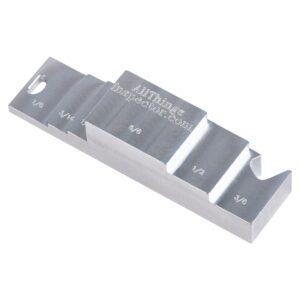ADA Inspections | Are you Leaving Money on the Table by not Having One?
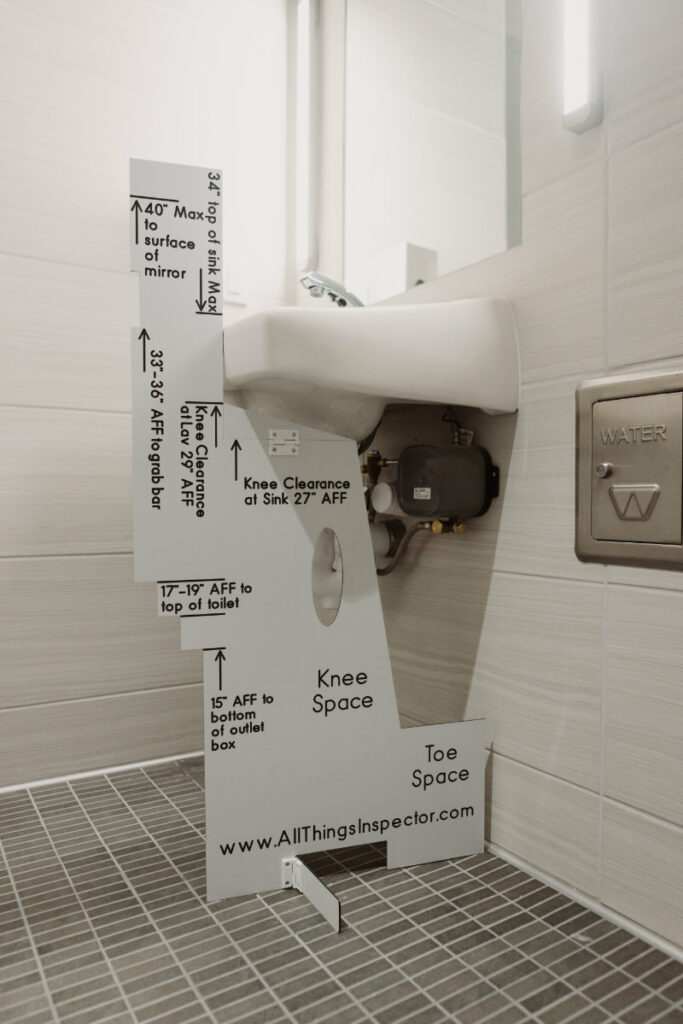
The above picture is of our ADA Measuring tape
Below we have some
convenient links to learn a little more about ADA.
The Best Tool to Check ADA Inspection Requirements is the ADA Measuring Tape.
Our ADA Template AKA the ADA Measuring Tape will make quick work of your ADA inspection whether you need to check ADA sink clearances or ADA Knee Clearance and looks professional in your reports.
If you do ADA inspections and want to have the most professional looking reports to impress your clients all while saving time and money look no further and grab your ADA Measuring Tape today.
The Importance of an ADA inspection
ADA compliance refers to the Americans with Disabilities Act, a federal law passed in 1990 that prohibits discrimination against individuals with disabilities in various areas of public life, including employment, transportation, and access to goods and services. This ADA compliance includes ensuring that buildings, websites, and other spaces are accessible to people with disabilities.
A Certified Access Specialist (CASp) is a professional certified by the state of California to inspect buildings and sites for compliance with state and federal accessibility laws, including the ADA. (CASp) are not required by law, but California encourages building owners, businesses, and others to have their properties inspected by a CASp to ensure accessibility for all. (CASp) are trained and experienced in identifying accessibility barriers and providing recommendations for making spaces accessible.
In summary, ADA compliance is essential to ensure equal access to buildings and spaces for all individuals, including those with disabilities. (CASp) play a crucial role in this process by inspecting and providing recommendations for compliance.
What if my business is tax exempt?
What are CASp Inspections and ADA Compliance?
CASp inspections are a specialized service offered by Certified Access Specialists (CASp) that helps ensure compliance with the Americans with Disabilities Act (ADA) and other state and local accessibility laws. These inspections are designed to identify any accessibility issues or deficiencies in a property and provide recommendations for addressing them.
During a CASp inspection, the inspector will evaluate the accessibility of entryways, parking areas, restrooms, elevators, and other areas open to the public. They will also assess the accessibility of the pathways, signs, lighting, and other elements required to make a building or property accessible to people with disabilities.
The inspector will take detailed notes and photographs of any accessibility issues or deficiencies that are identified and provide a report of their findings. This report will include recommendations for addressing identified issues and cost estimates for necessary repairs or modifications.
CASp inspections are necessary because they help property owners and managers ensure that their properties are accessible to all individuals, including those with disabilities. By identifying and addressing accessibility issues, CASp inspections can also help prevent lawsuits related to accessibility and ensure compliance with the ADA.

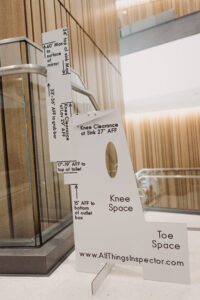
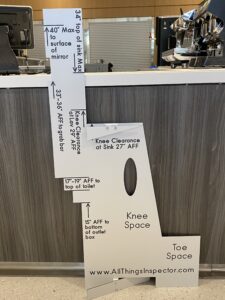
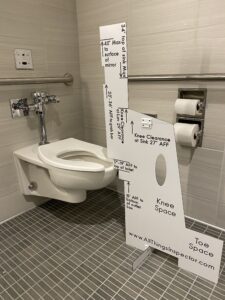






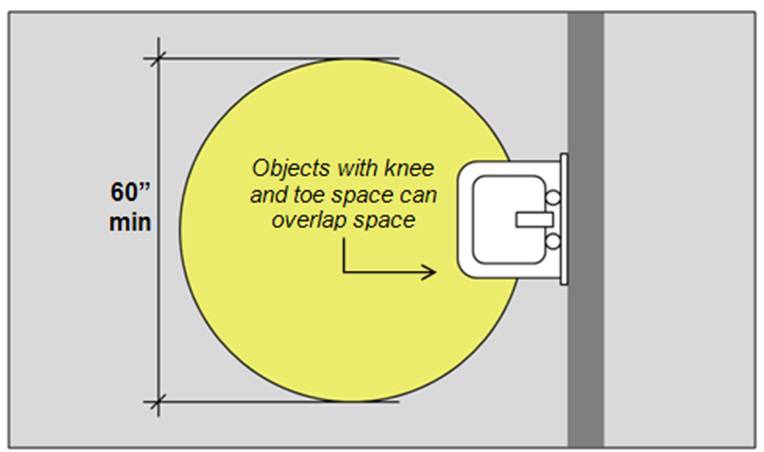
The CASp Inspection Process:
The CASp inspection process typically includes the following steps:
- Plan Review: Before the site inspection, the (CASp) inspector will review architectural plans for new construction or renovations to ensure that they comply with the accessibility requirements of the ADA and any other applicable laws.
- Site Inspection: The inspector will conduct a thorough inspection of the property, including the exterior and interior spaces, parking areas, and any other areas that are open to the public. During the inspection, the inspector will identify any accessibility issues or deficiencies and take detailed notes and photographs of them.
- Report Preparation: After the inspection, the inspector will prepare a detailed report of the findings. The information will include a summary of the inspection, a list of any accessibility issues or deficiencies that were identified, and recommendations for addressing them. The report will also include cost estimates for any necessary repairs or modifications.
- Review and Approval: The inspection report will be reviewed and approved by the (CASp) inspector and made available to the property owner or manager.
- Follow-up: The property owner or manager will have time to address any issues identified in the report and schedule a follow-up inspection to ensure that all issues have been resolved and the property is in compliance with the ADA.
- Certification: If the property passes the follow-up inspection, the (CASp) inspector will issue a certificate of compliance with the ADA.
By following this process, CASp inspections help property owners and managers ensure that their properties are accessible to all individuals, including those with disabilities, and mitigate the risk of lawsuits related to accessibility.
Door Inspection Products
-
ADA Door Pressure Gauge Push-Pull, 0-35lbs
$59.99 Add to cart -
ADA Push Door Pressure Gauge
$29.99 – $89.97 Select options This product has multiple variants. The options may be chosen on the product page -
Fire Door Inspection Tool
$29.95 Add to cart
Some of our Previous Clients Include
















Learn more about ADA Knee Clearances and making your ADA Sink Clearance inspection more accurate and efficient.
What is an Evaluation of Service Animals:
Evaluating service animals in a property involves understanding and following the rules and regulations set forth by the Americans with Disabilities Act (ADA) and other state and local laws.
- Identification: A service animal must be identifiable as a working animal, typically using a vest, harness, or ID card. Service animals are not required to wear a specific type of identification, but it’s a best practice for businesses to have some form of identification to differentiate them from pets.
- Task-trained: A service animal must be trained to perform tasks to benefit a person with a disability. The functions performed by the service animal must be directly related to the individual’s disability.
- Behavior: A service animal should be well-behaved and not display aggressive or disruptive behavior.
- Ownership and care: The individual with a disability is responsible for the care and supervision of the service animal. Property owners and managers can only require the service animal to be removed from the property if the animal is out of control or not housebroken.
- Safety: Property owners and managers should ensure that service animals are safe and comfortable while on the property by providing water and a quiet area for the animal to rest.
- Access: Service animals must be allowed to accompany the individual with a disability in all areas of the property where the public is normally allowed to go.
Property owners and managers should be familiar with the rules and regulations related to service animals and ensure they follow them to ensure compliance with the ADA. It is also important to remember that service animals are working animals and should be treated with respect and given the necessary accommodation to ensure their safety and comfort.
Are all Building Required to be ADA Compliant?
Not all buildings must comply with the Americans with Disabilities Act (ADA). The ADA sets minimum standards for accessibility and applies to facilities that are open to the public or used by employees.
The ADA applies to new construction and alterations made after January 26, 1992. It applies to a wide range of facilities, including but not limited to government buildings, commercial facilities, and places of public accommodation such as hotels, restaurants, and retail stores.
However, certain types of facilities are not covered by the ADA. For example, the ADA does not cover private clubs and religious organizations. Additionally, certain types of housing are not covered by the ADA, such as single-family homes sold or rented without a broker and owner-occupied buildings with no more than four units.
However, it is essential to note that some state and local laws may have stricter accessibility requirements than the ADA and may apply to buildings not covered by federal law. It is always advisable to check with the local authorities to ensure the regulations apply to your property.
Retrofitting and renovations:
Retrofitting and renovations:
Retrofitting and renovating existing buildings to make them compliant with the Americans with Disabilities Act (ADA) can be a complex process. It can vary depending on the type of property and the specific accessibility issues that need to be addressed.
- Assessment: The first step in retrofitting or renovating a building to make it compliant with the ADA is to conduct an ADA Inspection or assessment of the property. This assessment will identify any accessibility issues or deficiencies that need to be addressed.
- Planning and design: Once the assessment is complete, a plan for retrofitting or renovating the property will be developed. This plan will include specific design elements and details for addressing the accessibility issues identified in the assessment.
- Construction: After the plan is approved, the construction process can begin. This can include installing ramps, widening doorways, adding accessible parking spaces, and other modifications to make the property accessible.
- Costs: The costs associated with retrofitting or renovating a building to make it compliant with the ADA can vary widely depending on the size and complexity of the project. The fees can include design and planning, materials, and labor.
- Benefits: By retrofitting or renovating existing buildings to comply with the ADA, property owners and managers can ensure that their properties are accessible to all individuals, including those with disabilities. This can increase the customer base, improve customer experience, and mitigate legal risk.
- Accessibility compliance can also demonstrate social responsibility. It can be cost-effective in the long run as it eliminates the need for retrofitting and renovations in the future and eliminates the risk of costly lawsuits.
Property owners and managers should invest in retrofitting and renovating existing buildings to make them compliant with the ADA. Not only is it a legal requirement, but it also brings many benefits to businesses and society. It increases the customer base, improves customer experience, mitigates legal risk, and demonstrates social responsibility. Additionally, it can be cost-effective in the long run as it eliminates the need for retrofitting and renovations in the future and eliminates the risk of costly lawsuits. It is vital for businesses to invest in accessibility compliance; it will help society and the business grow.

Learn more about ADA Knee Clearances and making your ADA Sink Clearance inspection more accurate and efficient.



